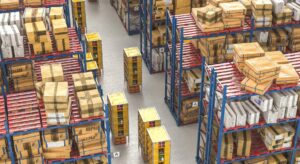As one of the world’s most popular eCommerce platforms, Shopify is the backbone, and technological infrastructure for many successful SMEs, multichannel mid-market retailers, and omnichannel global brands.
A common stumbling block that Shopify-powered merchants face, is with their physical order processing operations; running out of warehouse space can hinder their ability to meet rising demand, and poor inventory management can impact the way a retailer can deal with capital allocation.
In this article, we discuss the power of eCommerce fulfilment, how a Shopify store can find the right one, and how to know whether outsourcing third-party logistics is worth doing in the first place.

What is Third-party Logistics (3PL)?
Since the dawn of agriculture, mankind has had a need to stockpile goods in bulk. It wasn’t until the industrial revolution though, that the concept of warehouses was born. The subsequent centuries gave rise to electricity, the internet, and then online trade, and following closely behind eCommerce growth, were providers who can support with shipping and fulfilment.
In today’s world, 3PL is the process of entrusting a specialist, separate business entity to orchestrate the goods intake, picking, packing, shipping, and increasingly, the end-to-end customer experience, on behalf of a retailer, wholesaler, or brand. Due to the explosive growth of electronic commerce over the last few decades, demand for fulfilment warehousing is on the rise, and so too is the breadth of 3PLs’ capabilities.
Logistics experts now also offer additional, complementary services such as customs clearance, product customisation, outsourced customer support, and in the case of 4PLs and 5PLs, outsourced manufacturing, procurement and strategic consultancy, reaching deeper into the supply chain.
Finding the Right Shopify 3PL
As covered in the last section, 3PLs are diverse, so there’s plenty of choice, whether you’re a small or large business. What matters most is deducing whether you actually need to outsource order fulfilment in the first place. 3PLs typically require a minimum daily order commitment of 10 to 30, and others that specialist in mid-market and major global brands demand 300 shipments per day average.
If you aren’t hitting these numbers yet, then it would be more efficient to insource fulfilment and do it in-house. While processing order in-house can be laborious, it gives you greater control. The downside is that you will have less time to spend on other areas of business operations, such as sales, marketing and new product development.

Let’s assume you are shipping the required order volumes, then you will be best advised to find a fulfilment provider that specialises in Shopify, and has a track record of helping Shopify stores scale. 3PLs will typically cater for multiple eCommerce platforms, such as WooCommerce and Magento, and also sales channels, or marketplaces, including eBay and Amazon.
Furthermore, fulfilment centres can usually help with a wide range of product verticals and industries, but a good sign is if your particular sector is covered on their website. Some fulfilment centres focus on bulk shipments, as a B2B concern, whereas most offer B2C fulfilment for all sorts of categories, such as clothing, health and wellness, sporting goods and homewares.
3PL pricing is determined by a broad set of variables, including storage space, shipping and returns fees, picking and packing charges, software usage, integration and implementation costs, along with additional services such as handling customers’ queries, reworking goods into bespoke packaging, and time spent with customs paperwork.
Finally, the obvious points are to check 3PLs’ third-party client reviews, their clients’ customer reviews, and their employee feedback on Glassdoor. After all, a happy workforce is likely to be more performant, and this can benefit your reputation, and ultimately your customer lifetime value.
How eCommerce Fulfilment Works?
Ecommerce logistics begins with the integration of a retailer’s technology, with the fulfilment house’s warehouse management system (WMS), which includes barcode scanning technology, inventory control, and the production of shipping labels. Following that, alignment of key contacts at both parties, along with instruction to suppliers of the new fulfilment warehouse location, will ensure both client and 3PL are ready to begin processing orders.
Once a customer places an order via the retailer’s Shopify store, or marketplaces, the warehouse operative team will receive a picking note, and packing instructions. They will then collect the correct product(s) from the picking location, which could be a shelf, or pallet, and then take the product(s) to the packing bench, ready for packaging and application of the shipping label. Shipments are then grouped by courier (e.g. Yodel, Evri, DPD or DHL), ready for collection by the 3PL’s carrier partners, or carrier management company.
During the order fulfilment, customers will receive a shipping notification, along with tracking details, and subject to carrier service selection, in-flight delivery options such as timed delivery windows, the ability to leave a safe place, returns processing, and even photos of the parcel as it passes through the courier network.
The Future of Fulfilment Outsourcing
Predicted to nearly triple in size over the next five years, demand for fulfilment outsourcing is rampant. At the same time, Shopify has nearly five million stores, many of which achieving double-digit growth year-on-year. 3PLs will need to work harder to stand out, due to increased competition, and to achieve this, they will need to leverage AI and IoT technology throughout their infrastructure, to drive efficiency, and also broaden their service offering.
Going forward, consumers will continue to demand higher sustainability, along with fast, free, yet environmentally-friendly shipping. Tomorrow’s most successful 3PLs will leverage the latest technology to drive profitable insights for their clients, such as the ability to avoid overstocking and understocking. The most successful fulfilment services will partner with eCommerce solutions providers, and negotiate discounted shipping, and packaging rates on their clients’ behalves.








GIPHY App Key not set. Please check settings